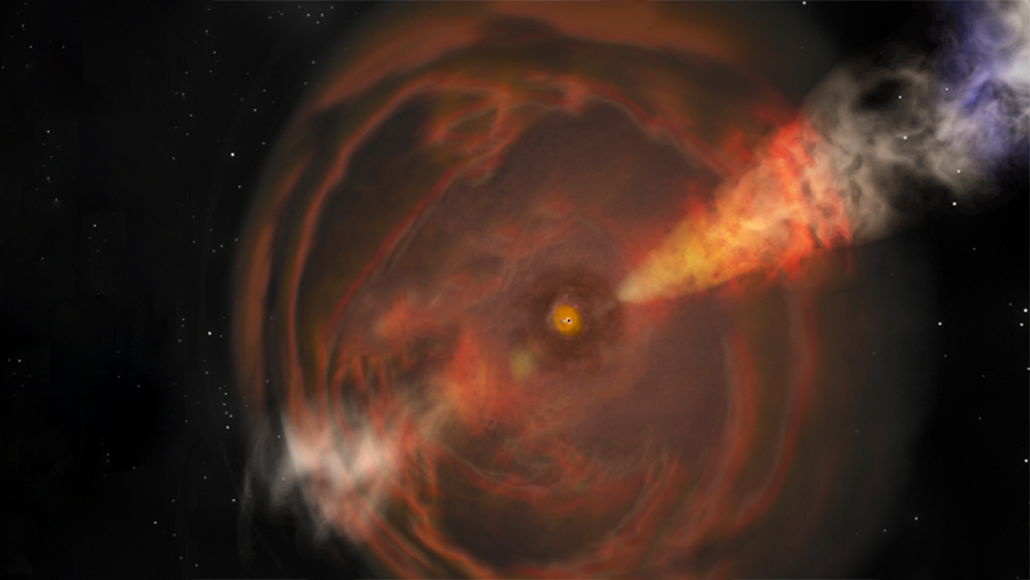A weird cosmic flare called the ‘Cow’ now has company
Scientists report two other bursts similar to a luminous, short-lived glow spotted in 2018

Three mysterious cosmic flares could be explained by the explosion of a star (illustrated) with a high-speed outflow of material powered by a central "engine" such as a black hole. This engine could launch jets of debris outward at blistering speeds.
Bill Saxton, NRAO, AUI, NSF
- More than 2 years ago
First, astronomers discovered the “Cow.” Now they’ve rounded up a small herd.
A short-lived celestial flare-up with a bovine nickname has been joined by two similarly unusual outbursts. The mysterious events were brighter than typical supernovas, explosions of stars that are a common source of temporary light shows in the sky. And the novel bursts came and went quickly, with their visible light brightening and dimming over days instead of the weeks typical of normal supernovas.
As particularly luminous examples of a poorly understood class known as fast blue optical transients, the three novel bursts have unknown origins. But they seem to be kin. “It’s like people going out to find different creatures and find out how they’re related to each other. We’re in the early stages of the ‘zoology’ of this class,” says astronomer Anna Ho of Caltech.
Detected in June 2018, the Cow earned its moniker thanks to the automatically assigned letters within its official astronomical name, “AT2018cow.” It is joined by the “Koala,” Ho and colleagues report in the May 20 Astrophysical Journal. Named for the ending letters in its handle, ZTF18abvkwla, the Koala appeared in September 2018. The third event, reported in the May 20 Astrophysical Journal Letters, resisted cute nicknames. Known as CSS161010, it was detected before the other events, in 2016, but its significance wasn’t understood until now.
A possible explanation for the events is that they result from an unusual type of supernova, one that explodes into a dense shell of material. For all three events, telescopes detected radio waves in addition to a short-lived flare of visible light. Those radio waves could have been produced by accelerated electrons, kicked up when a blast of debris from the explosion slammed into that surrounding shell. If an aging star shed its outer layers before it exploded, that could have created the sheath (SN: 6/21/19).
But the events are still enigmatic. “We don’t actually know what they are yet,” says astrophysicist Deanne Coppejans of Northwestern University in Evanston, Ill., a coauthor of the paper on CSS161010. Scientists still can’t rule out the possibility that the events could be the result of a black hole ripping apart a star, rather than the aftermath of a supernova, she says.
After the Cow was discovered, scientists had speculated that whatever created it may have involved some kind of cosmic “engine,” a dense object like a black hole or spinning neutron star that could add some oomph to the eruption by launching powerful jets of material. Now, in light of the two teams’ new results, “I’m driven to think that there really is some kind of central compact object driving these explosions,” says astrophysicist Brian Metzger of Columbia University.
That’s because the two new events both spewed matter at blazing speeds. The Koala ejected its detritus at more than 38 percent of the speed of light; CSS161010’s ejecta reached more than 55 percent light speed. The Cow’s offal reached a relatively measly 10 percent of the speed of light. In the case of CSS161010, the researchers also observed X-rays, which could likewise have been stirred up by such an engine.
Scientists have been regularly detecting fast blue optical transients only for the last several years. Transient blips of light in the sky are spotted by comparing different images taken of the same locations at different times. In the past, telescopes surveyed the sky at intervals short enough to catch normal supernovas but missed briefer events. Faster-paced surveys have recently made it possible to spot changes that occur on timescales of days. Those surveys include the Zwicky Transient Facility, which detected the Koala, and the Catalina Real-time Transient Survey and the All-Sky Automated Survey for Supernovae, both of which detected CSS161010.
But watch this space: “There are more surveys coming online that are going to be capable of detecting these things,” says astrophysicist Patricia Schady of the University of Bath in England. That could include the Vera Rubin Observatory, which will start up in 2022 (SN: 1/10/20). To fully pin down the source of the events, Schady says, “we really do need more of these things.”







